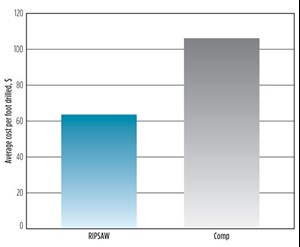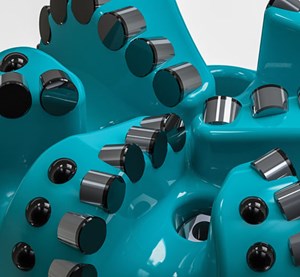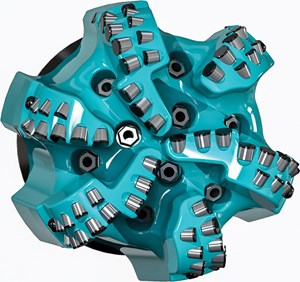A Texas drill bit manufacturer, aligned with the industry’s urgent need to lower OPEX, is supporting operators and drilling companies through continuous improvement andinnovation with a new PDC bit that is establishing significant benchmarks.
The patent-pending RipSaw PDC bit, with active torque technology, acknowledges the bottomhole assembly (BHA) components above the bit by controlling torque fluctuations and depth of cut without limiting ROP. The faster, smoother, more efficient drilling absorbs forces to control vibration and redirect drilling to reduce bit failures and trips for operators, saving time and money, with longer tool life for drilling companies.
Because Ulterra manufactures their bits with an end-performance goal in mind, the new RipSaw bit works in-conjunction with the BHA components above the bit. These components can include the motor, RSS, MWD/LWD, reamers, and anti-stick-slip tools further up the BHA. The PDC bit acts like a dynamic, active shock absorber of the torque and redirects harmful vibration. The smoother torque delivery allows the BHA to operate to its full potential, such as motors running at max-diff without stalling or allowing the LWD to get better readings, because the wellbore is smoother and the tool standoff is consistent.
The torque technology works across the PDC bit’s entire depth of cut range, because it is also part of the active cutting structure. Rather than using passive, secondary cutting structure elements, the bit is engineered differently. The cutting elements’ orientation is designed into the primary cutting structure, to deliver a manageable torque and vibrational response across the entire operating range of the bit with lateral stability and improved directional control.
With this technology innovation, the Ulterra R&D team has delivered a new PDC bit that offers smooth and consistent engagement of the rock. That stable engagement allows maximum efficiency above the bit for motors and tools, a reduction in drillstring dysfunction, and improved drilling overall. In real drilling environments, where downhole conditions are changing continually, this balance is vital. RipSaw is setting records in transitional drilling and complex directional sections.
UNPREDICTABLE AXIAL FORCES
The RipSaw technology story began in 2018, in the Permian basin, when a major U.S. operator, working with other industry leaders, invited Ulterra to devise a solution for drilling the challenging 12¼-in. intermediate sections. Because of the transitions between layers of harder and softer rock, PDC bits were experiencing difficulties with differing force concentrations across the cutting structure, leading to potential cutter overload and premature bit failure. In the most challenging applications, the bit often failed to get through closely stacked layers. The solution at the time compromised durability and speed with slower ROP. The industry was looking for a new solution.
The Ulterra R&D team began this project, as all others, with one simple question: What problem are you trying to solve? After a series of meetings, the team correctly identified that the slower ROP, durability issues, and bit failures were caused by interfacial severity. Going a step further, interfacial severity was deconstructed to understand that the bit profile was subjected to uneven loads from hard and soft lithologies at the same time. The question became: How do we deal with unpredictable axial forces without limiting performance? With that, depth of cut control became the next target for review.
Depth of cut is a measure of cutter engagement with the formation while drilling. In traditional bit design, depth of cut control prevents PDC cutters from penetrating deep into the formation, using fixed elements added to the bit face. While effective, the technology limits engagement and compromises drilling through alternating hard and soft formation layers. This creates erratic axial cutting forces that could be distributed better, instead of simply limited. During one brainstorming session, attention turned to Ulterra’s CounterForce technology that manages similar erratic cutting forces to control lateral movement of the bit.
Given the success of CounterForce at dampening forces in a lateral direction, the question was asked whether the same principle could apply in the axial direction. With further discussion and internal testing to confirm the hypothesis, RipSaw was born. The name signifies alternating angled cutters that work side-by-side to better distribute the drilling forces across the entire cutting structure.
The secret to the bit’s active torque technology is to incorporate low and high backrake angle cutters across the profile of the bit, Fig. 1. The high backrake cutters resist change in depth of cut, leading to smoother torque and control of drilling forces, while the low backrake cutters still allow the bit to drill ahead with good ROP. The geometry of the high backrake cutters is distinctive. The harder the cutters are pushed, the more they resist; in this way, the cutters act like shock absorbers in a car, smoothing out bumps and forces, without preventing full range of depth of cut where required. These engineered design elements neutralize the depth of cut issue through hard and soft layers.
TRANSITIONAL DRILLING
As the bit transitions between hard and soft layers, parts of the bit profile experience variable loads as the weight moves and concentrates on a small number of cutters in contact with the harder rock. Concentrating the drilling load on a small number of cutters like this can result in damage and vibration.
RipSaw PDC’s unique cutter layout is more capable of handling these variations and concentrations of drilling forces. The high backrake cutters, strategically placed around the profile, help to spread the weight across the bit face, as drilling continues through transitions so that all the energy does not concentrate on a small number of cutters. At the same time, the more aggressive cutters continue to allow the bit to drill ahead with good ROP. This simple action significantly reduces the amount of bit damage, so that it stays sharper, drilling more efficiently longer.
Operators have extensively tested and field-proven this bit technology in transitional drilling, the technology’s original target application. In West Texas intermediate sections, widely regarded as one of the most challenging transitional drilling applications in the world, an extensive field study documented that RipSaw had saved operators millions of dollars.
NEW PDC BIT STANDARDS
Ulterra conducted a six-month field study in West Texas to capture and characterize the effect that the RipSaw PDC bit had on the 12¼-in. intermediate section. The study included the full spectrum of bit runs by Ulterra and other drill bit manufacturers in this application. The data totaled over 3,000 bit runs, across more than 2,100 wells, with the RipSaw bits making up over 400 runs in the study. This large sample size eliminated single-run anomalies, good and bad, to outline an accurate picture of the technology in such a tough section.
This section starts off fast and relatively easy, but the real challenge comes approximately two-thirds of the way through, when the bit encounters the Brushy Canyon formation. With a highly interbedded transitional lithology, the Brushy Canyon contains outcroppings and layers that require a balance between speed and durability. Drilling this section from shoe to target depth (TD) in one run is possible, but bits can be damaged through the transition of multiple layers of different rock types, as the physical properties vary wildly. Often, bits must be pulled before the end of the interval, which causes additional trip time, cost, and the need for a new bit to reach TD.

RipSaw PDC bit technology has improved this historical performance, making shoe to TD achievable more often. The study found that the bit technology had an 80% chance of drilling through the tough transitional part of the section, whereas other types of bits had only a 50% chance of doing the same. The study also found that the bits were capable of withstanding 25% more total drilling energy input, proving the increased durability with the technology. The saving was significant: The RipSaw bits’ average cost per foot was nearly 40% less than other bit types, Fig. 2, confirming this new PDC technology advantage for operators.
COMPLEX DIRECTIONAL WORK
When drilling the most complex directional sections, the key to success is smooth, controlled and precise drilling. The directional driller needs a consistent and predictable toolface, and a stable drilling assembly that maintains angle without moving around to keep the well on target. The only way to achieve this performance is through smooth and consistent torque delivery, transmitted through the drillstring from surface and produced as a reactive drilling force from the bit. The design of RipSaw specifically addresses this situation, improving reactive bit torque over traditional design.
Reactive bit torque is the net resulting force from pushing the cutters through the formation. Any changes in weight, rotational speed, or rock properties will cause this torque to vary as the depth of cut changes. Variation in torque is transmitted to the motor, RSS, or other steering components above the bit, causing them to swing and move.
Traditional bit design would limit depth of cut at the desired penetration rate, so the bit could be loaded and not change its drilling behavior. This method can be successful up to a point, but the bit’s performance is restricted to the “designed-in” limit, and any additional energy input is converted to friction and heat that have the potential to cause further drilling dysfunction.
RipSaw addresses this issue in a different way. The high backrake cutters resist rapid changes in depth of cut, but they permit a full range of penetration, because they are also active cutting elements. The unique geometry acts like a shock absorber to deliver smooth, stable, high drilling torque for maximum PDC bit performance. This improved cutting action delivers smooth torque and consistent toolface, giving directional drillers the controlled steering required to accurately place the well.
NO COMPROMISE REQUIRED
In the 9 ⅞-in. intermediate section of the Haynesville, RipSaw has become the only bit needed to drill the highly interbedded interval, with compressive strengths ranging from 3 kpsi to 25 kpsi, and despite contrasting challenges and requirements. This section contains the difficult Travis Peak and Cotton Valley formations that require durability and soft upper sections, which drill with fast ROP. The multi-well pad construction also means that complex directional work is needed to maintain wellbore separation.
In a typical section, the drill-out run is fast and mostly vertical; speed is the main requirement for approximately the first 5,000 ft. As the bit enters the sharp and abrasive sands of the Travis Peak, directional work begins with a nudge up to 20°, putting large forces through the cutting structure and challenging its durability. This part of the section is extremely damaging, so the initial drill bit will terminate quickly. Two further bit runs are needed to complete the directional work, which consists of a long tangent hold and then drop back to vertical before reaching section TD. Previously, the strategy would be to run an aggressive bit from the start for high ROP, wait until it wears out, and then pick up a very durable bit for the bottom part of the section. With RipSaw technology, the same bit type can be used throughout, streamlining inventory and decision-making but also delivering measurably better performance in each part of the section.
The RipSaw design can provide the necessary combination of high aggressivity that is needed at the top and durability required at the bottom of this section, Fig. 3. Normally, a design with such durability would be too slow in the upper part of the section, but with the addition of active torque technology, it achieves the opposite. The smooth and efficient drilling action converts drilling energy into cutting rock more effectively; and being without any static depth of cut limitation, the bit is free to drill as quickly as possible.
SOLVING MICRO-STALLING
Motors are an integral part of this type of directional work, and the qualities of RipSaw enhance the abilities of this drive type above the bit. Micro-stalling is a recently identified dysfunction in the drilling sphere, where the motor is constantly slowed by variations in the torque delivery from the bit, leading to a continuous degradation in the elastomers of the power section. As the motor accumulates more drilling hours, it will gradually weaken and lose the ability to provide both torsional energy and rotational speed. Since RipSaw delivers more consistent torque, it helps to preserve power section strength, which in turn leads to steady toolface, controlled directional response, and efficient power delivery.
The result is less time spent orienting and maintaining toolface, more time spent on bottom, and faster penetration rates as the assembly drills ahead. All these factors were required when a RipSaw-equipped bit achieved the Louisiana state record for a 9 ⅞-in. intermediate section, drilled in only 4½ days, using three of these bits through an 8,700-ft section. This Ripsaw design went on to achieve numerous additional 24-hr footage records in this application.
CONCLUSION
Engineered for above-the-bit synergy, RipSaw technology recognizes the performance connection between bits and the tools above them. The PDC complements all the above-the-bit components with a shock absorber effect that smooths out torque delivery. The unique backrake cutting structure, which embodies the active torque technology, allows the bit to drill ahead, with good ROP and controlled vibration in tough sections. Operators are saving considerable amounts of time and money by reducing expensive trips out of hole to replace previously damaged bits and BHA components, and getting the most value for money out of tools and equipment. As the industry demand for improved technology and efficiency continues, RipSaw PDC bits can be an essential part of the drilling plan.
- Coiled tubing drilling’s role in the energy transition (March 2024)
- Shale technology: Bayesian variable pressure decline-curve analysis for shale gas wells (March 2024)
- Digital tool kit enhances real-time decision-making to improve drilling efficiency and performance (February 2024)
- E&P outside the U.S. maintains a disciplined pace (February 2024)
- U.S. operators reduce activity as crude prices plunge (February 2024)
- Drilling advances (January 2024)
- Applying ultra-deep LWD resistivity technology successfully in a SAGD operation (May 2019)
- Adoption of wireless intelligent completions advances (May 2019)
- Majors double down as takeaway crunch eases (April 2019)
- What’s new in well logging and formation evaluation (April 2019)
- Qualification of a 20,000-psi subsea BOP: A collaborative approach (February 2019)
- ConocoPhillips’ Greg Leveille sees rapid trajectory of technical advancement continuing (February 2019)





